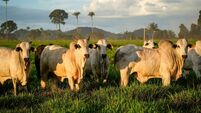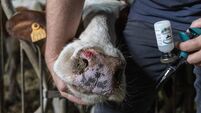Grant rules prevent excess solar energy from being sold off-farm

Senator Daly said there would be greater 'buy-in' by the farming community if there was some economic potential associated with the excess power produced.
Farmers anxious to sell excess energy to the national grid from solar panels have received the legislative equivalent of an electric shock.
That’s because electricity produced by grant-aided panels may be used only on the farm on which it is generated, both houses of the Oireachtas have been told.
Senator Paul Daly told the Upper House that TAMS, the targeted agricultural modernisation schemes, have been modified Welcoming the "exceptional opportunity" afforded to farmers to avail of a grant to install solar panels, he described the initiative was brilliant.
But, he said, European Union regulations stipulate that electricity produced by grant-aided solar panels may be used only on the farm on which it is produced.
"Dumping excess energy, rather than exporting it to the grid for use in a constructive manner, sends out the wrong message and narrative,” he said.
Senator Daly said there would be greater 'buy-in' by the farming community if there was some economic potential associated with the excess power produced.
He suggested that a contract where farmers would get credit during the winter for the power that they produce during the summer could be considered.
“It would enhance the drive to go green in the agriculture sector and alleviate the problems associated with some but not all of the energy shortages from which we are currently suffering,” he said.
Minister of State Pippa Hackett said it is not permitted under current European Union regulations and the new Common Agricultural Policy to sell excess energy generated by grant-aided investments to the grid.
“Energy generated can be consumed only on the holding," she said. "That is the nature of the grant, she said, explaining that the installation of panels with consumption on the farm is being aligned because that is the intent of the grant under the TAMS."
An application may be rejected or amended if the applicant cannot demonstrate that all of the electricity produced from the PV panels will be consumed on the agricultural holding.
Minister Hackett said that to-date the department has paid grant aid to 161 beneficiaries in respect of solar installations on farms.
Some farms have roof space, but that potential will not be achieved through the TAMS grant which is for the purpose of consumption on the farm and those are the rules attached to it.
However, it does not stop farmers from examining other options and possibly coming together in a community energy setting.
There are examples across Ireland where communities have come together to generate their own energy and incomes.
“I do not see why farmers should be any different. I encourage farmers who are interested in this to reach out to the Sustainable Energy Authority (SEAI) and come together,” she said.
The issue was also raised with Agriculture, Food and Marine Minister Charlie McConalogue in the Dail by Cork East TD and Minister of State David Stanton.
In a written reply, Mr McConalogue said TAMS has proven to be a "hugely successful" and "popular" scheme, driving farmyard improvements in every county.
But it is not permitted for excess energy generated by grant-aided investments to be sold to the grid. Energy generated can only be consumed on the holding.
Mr McConalogue said he was delighted, however, to recently announce, as part of the budget, that the electricity consumption of the dwelling house can be included with immediate effect on the solar survey as part of the holding for sizing the Solar PV installation.
The dwelling house must be occupied by the herd owner or family member and situated on the holding. This is now open for applications.
To encourage further increased take-up in solar applications, he was proposing to make further changes to the scheme.
These include increasing the kilowatts for solar applications in TAMS 3kW to 30kW from 11kW currently.
This will bring in more highly energy-intensive farms and cover their electricity usage through on-farm generation. The current limit of 62kW for the Pigs and Poultry Investment Scheme is also being retained.
Mr McConalogue said it is also proposed that the grant rate will increase to 60% and a standalone investment ceiling of €90,000 for solar panels on farms from 2023 onwards.
“In a time of rising energy costs, the scheme enables farmers to generate their own power for their dwelling and holding and will help to achieve a more sustainable rural economy, assisting farmers in reducing energy costs on their holdings,” he said.
The minister said the changes are subject to the approval of the Rural Development Plan amendment by the European Commission.
It should also be remembered that there are other state supports for the installation of solar panels, including from the SEAI. All farmers should be examining all options for support.











